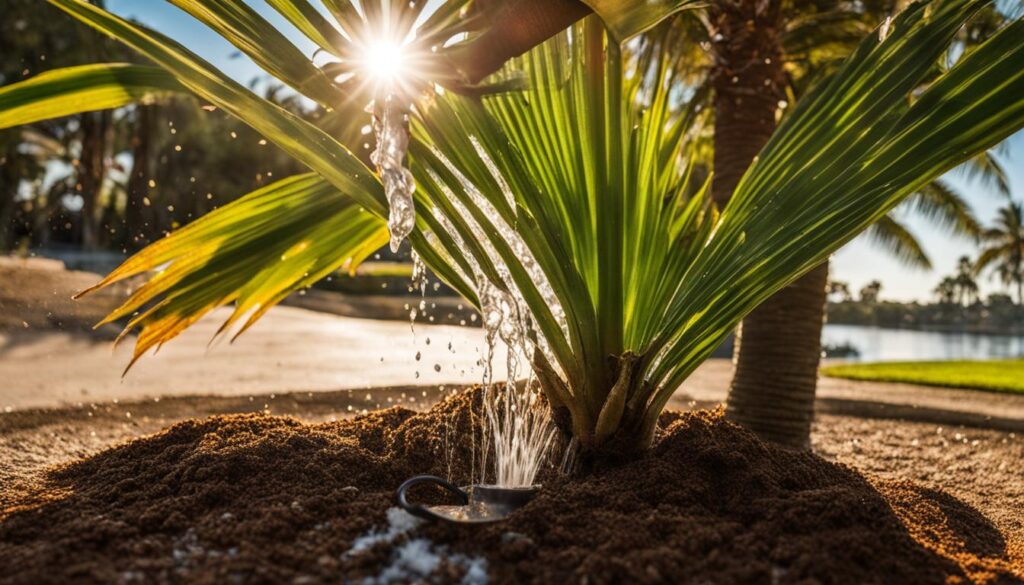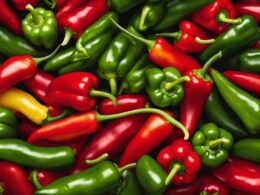Palm trees are a stunning addition to any outdoor space, adding a touch of tropical beauty and elegance. However, maintaining their health and vibrant green color can be a challenge, as these trees often suffer from nutrient deficiencies that can cause their leaves to turn yellow. If you’re wondering how to enhance the growth and greenery of your palm trees, Epsom salt could be the solution you’ve been looking for.
Epsom salt, also known as magnesium sulfate, can provide significant benefits to palm trees when used correctly. While it is not a complete fertilizer on its own, Epsom salt can supplement other fertilizers and provide additional magnesium to remedy magnesium deficiencies in palm trees. Magnesium is essential for the production of chlorophyll, which plays a vital role in photosynthesis and overall plant health.
By applying Epsom salt to the root zone of your palm trees, you can promote growth and lush greenery. However, it’s important to note that Epsom salt should be used alongside a balanced fertilizer specifically formulated for palm and tropical trees. This combination ensures that your palm trees receive all the necessary nutrients for optimal health and vitality.
Stay tuned to discover how to properly use Epsom salt for palm trees, including application tips, dosage, and frequency.
How to Use Epsom Salt for Palm Trees
To ensure the proper application of Epsom salt for palm trees, follow these guidelines:
- Dissolve Epsom Salt: Begin by dissolving Epsom salt in water to create a solution that can be easily absorbed by the roots of the palm trees. This process ensures that the magnesium sulfate in Epsom salt can be effectively utilized by the palm trees.
- Wear Protective Gear: It is recommended to wear protective gear such as gloves and goggles when handling Epsom salt. This precautionary measure ensures your safety during the application process.
- For Outdoor Palm Trees: Spread 2 to 4 pounds of Epsom salt evenly around the root zone of outdoor palm trees approximately four times a year. The root zone refers to the area encompassing the spread of the tree’s branches. This dose is suitable for promoting growth and maintaining the health of your palm trees.
- Water the Area: After applying Epsom salt, water the area surrounding the palm trees. This will help dissolve the salt and facilitate its absorption into the soil, making it readily available for the roots of the palm trees.
- For Indoor or Potted Palm Trees: Excess salt buildup can occur in the soil of indoor or potted palm trees, leading to yellowing leaves and root damage. To remove harmful salts, mix 1 teaspoon of Epsom salt with 1 gallon of water. Carefully pour this solution into the potting soil, ensuring thorough saturation. Repeat this process three to four times, allowing the excess salts to leach out. Finally, return the palm tree to its original location.
- Homemade Fertilizers: Although homemade fertilizers using Epsom salt may be tempting, it is important to note that they may not provide all the necessary nutrients for palm trees. Scientifically formulated fertilizers specifically designed for palm trees are generally more effective in providing the required nutrients for optimal growth and health.
By following these instructions, you can effectively use Epsom salt to support the growth and vitality of your palm trees.
Other Uses of Epsom Salt in the Garden
Epsom salt is not just beneficial for palm trees but also has multiple uses in garden care. One of its primary uses is as a natural fertilizer for a variety of plants. Whether you’re growing green vegetables, tomatoes, cucumbers, azaleas, roses, or fruit trees, Epsom salt can provide a boost of magnesium, an essential nutrient for plant growth and chlorophyll production. By incorporating Epsom salt into your gardening routine, you can enhance the color, vigor, and yield of your plants, ensuring they stay healthier and more robust.
In addition to being a fertilizer, Epsom salt can also act as a weed killer in your garden. By combining it with vinegar and dishwashing liquid, you can create a potent solution to effectively eliminate pesky weeds. Simply spray the mixture directly onto the weeds, and watch them wither away. However, it’s important to note that before applying Epsom salt to your garden, it’s advisable to test the soil’s magnesium levels to ensure it will be beneficial for your specific plants.
One of the standout features of Epsom salt is its non-toxic nature, making it safe to use in gardens shared with pets and kids. So, whether you’re looking to fertilize your plants or eliminate weeds, Epsom salt is a versatile and environmentally friendly option for your gardening needs.
Can Epsom Salt be Used for Chinese Fan Palm Care as Well?
Yes, Epsom salt can be used for Chinese fan palm care. Simply mix a few tablespoons of Epsom salt with water and apply the solution to the soil to give your Chinese fan palm a nutrient boost. This can help promote healthier growth and vibrant green foliage.










